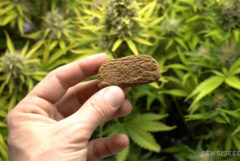Using cannabis and having a dry mouth seem to go hand in hand. Whether you call it dry mouth, cotton mouth or pasty mouth, it can be quite annoying! But do cannabis users just have to put up with it? Or is there a way to get rid of it? Here’s a look into studies that show probable causes, and what cannabis users can do to avoid a constant dry mouth.
Cannabis users all over the world are sure to be familiar with that sticky, dry, pasty sensation that affects the mouth after smoking cannabis. In fact, it is so inevitable that people rarely question the mechanism at work behind this strange little phenomenon—except for a handful of researchers who believe they know why it happens.
How is saliva formed?
First, we should take a brief look at the process of saliva production. It appears that saliva formation involves a two-stage process. Initially, specialised cells known as acinar cells secrete a fluid that is similar in composition to plasma. This fluid then passes through the salivary ducts on its way to the oral cavity, and as it does so, sodium and chloride are removed from it and potassium and bicarbonate are added to it. This process is what produces the final ‘hypotonic solution’ that is secreted into the mouth.

Secretion of saliva is controlled by the parasympathetic nervous system (PSNS). The PSNS is responsible for various metabolic processes related to food intake, appetite, and anticipation of eating.
Receptors in the salivary glands are activated via impulses from the chorda tympani nerve. This important nerve originates in the taste buds before travelling through the submandibular ganglion (the cluster of nerve cells in the submandibular gland) and on to the brain. The chorda tympani nerve releases a compound known as acetylcholine, which is one of the body’s main saliva-stimulating substances and works directly on the receptors of the submandibular gland.
Another important compound involved in salivary secretions is known as norepinephrine. This compound is released by the preganglionic nerves that lie upstream from the submandibular ganglion. It works directly on the myoepithelial cells that surround the acinar cells by causing them to contract, which then leads to the secretion of saliva.
CB-receptors in the salivary glands
Several studies show that cannabis use can cause oral dryness. In 1986, a study into the effects of cannabidiol (CBD) noted that the side-effects of administration of oral CBD included dry mouth. Since then, several other studies have also observed cannabinoid-induced oral dryness. The scientific name for oral dryness is xerostomia.

Perhaps the most in-depth study on cannabis-induced xerostomia to date was performed by researchers at the University of Buenos Aires, Argentina in 2006. The researchers found that cannabinoid receptors type 1 and 2 are present in the submandibular glands, which lie beneath the floor of the mouth and are responsible for producing 60-67% of the saliva.
The researchers found that the endocannabinoid agonist anandamide (AEA) binds with high affinity to the glandular cannabinoid receptors and blocks the action of the saliva-inducing compounds norepinephrine and methacholine, leading to a decrease in the secretion of saliva.
As mentioned above, these saliva-inducing compounds are part of the normal working of the parasympathetic nervous system. THC is also an agonist of the CB receptors, and is likely to affect the receptors of the submandibular glands in a similar manner.
The fundamental role of the endocannabinoid system
Interestingly, the Buenos Aires study also concluded that the role of the endocannabinoid system is not limited to blocking signals at the submandibular glands themselves. The nervous impulses that are expressed via the chorda tympani also originate in the brain.
The researchers hypothesized that intravenous administration of cannabinoids via the femoral vein not only exerted their primary effect via the submandibular glands, but may also have acted on the cannabinoid receptors in the brain itself. They argued that a central nervous system mechanism helps to control production of saliva at glandular level.

The fact that the endocannabinoid system is so fundamentally involved with the inhibition of salivary secretions implies that it also has a role to play in causing the production of saliva. If an agonist or antagonist of the cannabinoid receptors inhibits salivation, it is likely that an inverse agonist such as the synthetic cannabinoid AM-251 may cause a reversal of this effect and an increase in salivation.
Indeed, the Buenos Aires study also demonstrated that the presence of AM-251 partly reversed the effect of AEA (although there appears to be a lack of consensus as to whether AM-251 is an antagonist or an inverse agonist).
How to get rid of dry mouth after cannabis use
Experiencing a dry mouth and throat after cannabis use is extremely common, and often it does not take much cannabis to induce this effect. However, during a heavy session, the dry-mouth effect can often increase until it becomes extremely unpleasant.

If experiencing unpleasant cotton mouth, there are a number of things you can do to help alleviate it. A few of these include:
- Stay hydrated! This will mitigate the issue to some extent
- Chew gum – This can also help, as the action of chewing stimulates the salivary glands to produce more saliva
- Use ice cubes or lollies to suck on, which can also help keep saliva flowing
- Similarly, foods that require decisive chewing such as dried fruit or beef jerky can also help stimulate the production of saliva

For more complete relief, using a demulcent (a substance that coats a mucous membrane with a moist ‘film’) designed for oral use should suffice. Many different prescription medications can cause users to experience dry mouth, so there are numerous oral demulcents commercially available to combat the problem.
In the future, research into the specific nature of the endocannabinoid system and how it controls the process of salivation may yield targeted products that can reverse the effect of xerostomia. This would benefit not just those who have smoked a little too much cannabis, but also individuals suffering from a range of conditions (or taking certain medications) that cause a permanent state of cotton mouth.
- Disclaimer:This article is not a substitute for professional medical advice, diagnosis, or treatment. Always consult with your doctor or other licensed medical professional. Do not delay seeking medical advice or disregard medical advice due to something you have read on this website.











Very informative. Thank you.
THC helps dry up excess saliva for people who have MS and are forced to use a peg feed .
I was Tryna read all that
Using cannabidiol cream and spray for backpain since April 2015. Good response with reduction of pain but emergence of significant cotton mouth which awakens me at night and is negatively impacting sleep. Using xylitol and biotene mouth spray and xylitol gum. Drinking more water. I have never have smoked marijuana so I was not prepared for this side effect and had no warning from MJ doc.